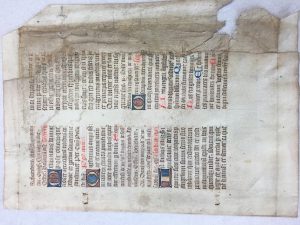When we started the manuscript color unit a couple of weeks ago, I wasn’t expecting it to alter my understanding of manuscripts that much. Sure, pigments and inks can be interesting, but for the most part aren’t they just kind of… decoration? I was pretty sure I’d hold on to this thinking, coast through, and finish the class strong. Somewhere in my research, that changed.
I was researching earth-tone color pigments when I needed a break– there’s only so much you can read about different shades of dirt. My boyfriend and I decided to go to dinner, and on the way I was telling him about the colors I was researching. He turned to me and said, “You realize what you’re talking about is literally my job?” My boyfriend and I are both Theatre majors, and he works as a scenic painter in the department. I had completely overlooked that fact that he spends his entire day working with the exact same pigments I was studying. He could immediately tell me everything I had just been researching, from the different uses of Van Dyke brown to the different shades of ochre to use on wood.
This experience got me thinking: if medieval pigments are still so relevant in today’s theatre, what other aspects of medieval manuscripts can we interpret theatrically?
First of all, there are so many physical qualities of manuscripts that are super performative. Elaborate colors (gold-leaf, purple, silver) or the absence of them, say a lot about the social status of the owner. It’s incredibly similar to seeing a character enter the stage in the first time. You see how they’re dressed, what colors they’re wearing, and you instantly know who they are. It’s Cruella De-Ville. It’s Annie. It’s Glinda. Those costumes immediately tell you almost everything you need to know about these characters.
Whether this status is accurate or fabricated is at the root of performativity. For example, we’ve studied several texts this semester that feature the commissioners actually inside the manuscript illustrations– in a Spanish Gradual in the Hargrett Collections, we have seen an abbess actually insert herself alongside angelic characters in an illustration. If that isn’t performance, I don’t know what is. It also goes to show that some of the certain “personalities” of the stage have been around forever.
Similarly, every Book of Hours or church-service-related manuscript that we’ve studied has had a strong relation to theatre. Because all church services are a form of theatre, the texts used (“breviaries”) are extremely similar to modern playscripts. As a playwright, this aspect is particularly interesting to me. There is “dialogue” in the texts, as many services would ask for responses or prayers from the “audience” or parishioners. If holding music, the breviaries would absolutely act as sheet music. Even just on a structural level, the ruling of manuscript pages are similar to stage directions (see the image below for obvious ruling of a manuscript we used in class). If stage directions tell actors where to go and what the scenes should look like, manuscript rulings certainly tell where the writing should go and what it should look like on the page.


After discovering all of these theatrical connections, I was able to connect more with the material on an academic level, but also on a person level. Suddenly, these weren’t just dusty old books to me. These were some of the first theatre scripts. They were testaments to the performance of royalty and godliness.
I encourage anyone studying manuscripts to come at them from an interdisciplinary angle that fits your specific interests. If you’re a chemist, there are so many tests to be done on pigment minerals. If you’re a linguist, you can certainly look at the Middle English (among other languages) to look for support or contradiction to what you know. Artists, obviously, have a wealth of knowledge to gain from the illustrations. If you’re a zoologist… well, I guess you could look at some of the animals depicted? Regardless, I’m a big believer that education should meet students at their interests. In understanding manuscripts as theatrical vehicles, I’ve gotten to broaden my education in two fields at once and had a lot of fun doing so!
[All photos taken by Abraham Johnson, blog post written by Abraham Johnson]